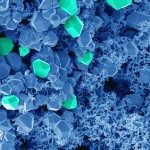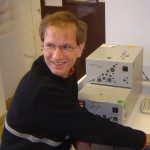Présentation
This project aims to describe the hydrodynamic and thermodynamic properties of the CyaA toxin and the conformational changes it undergoes during its translocation process across the lipid membranes of Bordetella pertussis (secretion) and of its eukaryotic target cell (intoxication). To this avail, we have combined a large array of biophysical methods available at the PFBMI (analytical ultracentrifugation, circular dichroism, dynamic and static light scattering, viscometry, fluorescence spectroscopy, infrared spectroscopy, isothermal titration calorimetry, surface plasmon resonance, dual polarization interferometry and microscale thermophoresis) or for which the access is organized by us (SAXS). Such a multi-technological approach has yielded a wealth of information which is highly complementary, and is an excellent example of the added value that an integrated facility such as ours can provide for the understanding of fundamental biological questions.
Originally, we principally focused on the Repeat Domain (RD) of CyaA, composed of about 40 Repeat in Toxin (RTX) motifs in tandem. We have shown that, in the absence of calcium (Apo-RD), RD was intrinsically disordered, with no stable secondary and tertiary structures and a high degree of hydration. Calcium binding induces compaction and dehydration of RD, along with the acquisition of a stable fold (Holo-RD). We have shown that a similar behaviour occurs in a highly crowded environment, induced by high concentrations of Ficoll, that we used as a model of cellular crowding. This calcium-induced conformational switch is likely to be a key feature of the secretion process of CyaA, as it passes from the low calcium concentration bacterial cytosol to the high calcium concentration extracellular medium.
More recently, we have concentrated our efforts on the catalytic domain of CyaA. Parallel multi-technological experiments have allowed us to characterize the conformational and hydrodynamic changes that the catalytic domain (AC) of CyaA undergoes, upon binding to the target cell membrane, and after intoxication when it binds to calmodulin in the eukaryotic cytosol. While calmodulin triggers only minor modifications of the structure of AC, it has a pronounced effect on its hydrodynamic properties. Indeed, while the isolated AC is spherical and hydrated, it undergoes a significant elongation upon calmodulin binding, together with a concomitant compaction and dehydration. This data have ultimately been confirmed by a thorough SAXS study (manuscript in preparation).
Finally, we have used the knowledge acquired for the different domains of CyaA to understand the behaviour of the full length protein in the presence or absence of calcium. Folding of CyaA into a monomeric form was found to be critically dependent on the presence of calcium and post-translational acylation of the protein. Monomeric CyaA preparations display high hemolytic and cytotoxic activities suggesting that the monomer is the genuine physiologically active form of the toxin.











